If you can believe it, there are wearables for your baby.
The word “tech” now refers to more than just a device that sits on your shelf at home or one that you carry in your pocket. Tech is wearable, and it’s everywhere. There are fitness trackers, smartwatches, smart clothes, virtual reality headsets, children’s toys, and much more.
Related: See our Top Smartwatches For Kids article.
If you absolutely hate wearables and you’re waiting for them to disappear, you won’t want to read this next bit. IDC Research is expecting the wearable market to ship a total of 126.1 million units in 2019. In other words, the wearable market will only continue to grow.
So, it’s no surprise that we’re starting to see wearables tailored for infants and their parents. Adults aren’t the only ones that can benefit from modern tech. Just take a look at devices like the FiLIP smartwatch or Moff Band. They extend the wearable experience to younger audiences while still delivering feature support to parents – through activity and location tracking. Disney even has a new line of toys – called Playmation – that uses wearable technology to enhance a child’s playtime, and encourage them to use their imagination.
But wearable tech has a lot more to offer than just added convenience and fun. It can be both practical and useful when deployed in certain ways. Think baby monitors that are evolved to keep up with today’s world. Since baby monitors have existed for decades and are not getting any less useful, it’s about time that they see a few modern advancements; like real-time monitoring of a baby’s health stats.
Imagine being able to check on your newborn no matter where you are? A system that allows this might send alerts to your smartphone the very second their heartbeat or breathing patterns turn abnormal. It might also inform you about how much sleep your baby is actually getting, and what the quality of that sleep is. These scenarios are all possible thanks to wearable tech.
Before we take a look at some of the awesome gadgets that exist, let’s consider the risk of using such devices.
You may be the type of parent who considers using wearables worth the risk, or you may feel the opposite, that’s it’s never worth the risk. There’s nothing wrong with either line of thinking – though many will argue their side is superior. However, it’s important that you do have all the details so you can make that decision yourself as a parent.
Wearables for Your Baby Emit Wireless Signals That are Possibly Carcinogenic
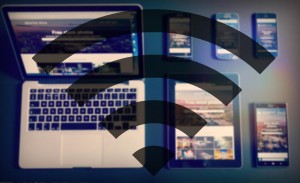 Before we begin, it’s extremely important that we clarify we are not taking a stance on this topic. We are not arguing for – or against – the idea that wireless signals like those that come from cell phones and smart devices are a possible carcinogen. But because it comes up a lot when people are discussing devices like this, we felt it was pertinent to offer sources so you can conduct your own research.
Before we begin, it’s extremely important that we clarify we are not taking a stance on this topic. We are not arguing for – or against – the idea that wireless signals like those that come from cell phones and smart devices are a possible carcinogen. But because it comes up a lot when people are discussing devices like this, we felt it was pertinent to offer sources so you can conduct your own research.
Obviously, if this is a topic that concerns you – one way or the other – we encourage you to do your own research instead of just viewing the links we provide here. Feel free to discuss this in the comments below! We do ask that you remain courteous to one another, and also to our team.
The International Agency for Research on Cancer has classified the electromagnetic fields produced by mobile phones as a possible carcinogen to humans. This does not mean there is irrefutable evidence that suggests this technology is harmful. It is still largely debated on both sides.
Here are some resources you can browse to find out more information:
- International Agency for Research on Cancer: Report Press Release
- World Health Organization: Electromagnetic Fields and Public Health
- Environmental Health Trust: WHO/IARC Position on Wireless and Health
- Environmental Health Trust: Children and Wireless FAQ’s
- Science-Based Medicine: Are Cell Phones a Possible Carcinogen? By Lorne Trottier (Editorial)
- Forbes: Why Scientists Say Wi-Fi Signals Won’t Give Your Kids Cancer (Editorial)
Again, please use these resources to make an informed decision whether or not you want to risk exposing your baby to wireless signals produced by wearable tech. These sources were chosen not because of the outlook they have on the issue but because of the valuable information that is provided within.
Barring the Risk, Why Use Wearables for Your Baby?
As with most things “smart,” this kind of technology is convenient in more ways than one. It can improve the way we interact with our loved ones, but sometimes it just makes life easier.
Many wearables for your baby will allow you to monitor them remotely while they are sleeping, which is something new parents spend a lot of time doing anyway. They will not take away the responsibilities of parenting, obviously, and you still need to check on your baby from time to time. However, something like the Owlet sock allows you to know instantly when something is wrong after detecting abnormalities in a measured heartbeat or breathing pattern.
We’re not proposing you use every single one of these gadgets. A little natural care from mommy and daddy is always the best method. Yet, one or two of these wearables for your baby might make your life easier – or allow you to get a few extra minutes of sleep – and that can be valuable as a new parent, heck even as a long-time parent too.
The Top 10 Wearables for Your Baby
The biggest question you’ll hear from others about digital or connected parenting is: why? People have lived without these gadgets and devices for centuries. Why do we need them now?
These are valid questions, but they all have a valid answer. These wearables for your baby offer convenience and peace of mind. Many of them track a child’s vitals and let the parents know if their little one is safe, comfortable, or in danger. Since babies cannot communicate when something is wrong – other than screaming or crying – these devices can help parents react to a bad situation much faster.
Before you write them off, take a look at some the wearables for your baby listed below and pay attention to what they can do.
1. Sproutling
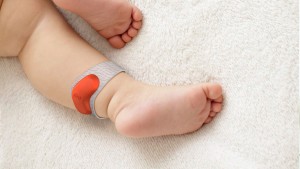 Sproutling is a unique baby monitor that measures an infant’s vitals and relays that information back to Mommy and Daddy to let them know their child is comfortable and safe. It monitors data like heart rate, skin temperature, and the baby’s sleeping position. In addition, if the baby moves or repositions in their crib Sproutling will detect it.
Sproutling is a unique baby monitor that measures an infant’s vitals and relays that information back to Mommy and Daddy to let them know their child is comfortable and safe. It monitors data like heart rate, skin temperature, and the baby’s sleeping position. In addition, if the baby moves or repositions in their crib Sproutling will detect it.
The company calls it the “world’s first sensing, learning, predicting baby monitor.” It slides comfortably around the baby’s ankle and pings all information to a smartphone companion app. What’s most interesting about it is that it will learn your child’s sleeping patterns and habits, and can predict how long your little one is going to sleep. It sounds crazy, but this will give you some idea of how long you have before baby wakes. It will also tell you if your baby slept well, or poorly so that you can better predict how they’ll act when they wake up.
A sound sensor will monitor the levels inside the nursery – or bedroom – where the baby is sleeping. This is great if you have company over, or for when you’re watching TV and you want to know if you’re being too loud.
More importantly, the app will alert the parents if it notices something out of the ordinary like irregular movement or vitals.
2. Mimo Onesie
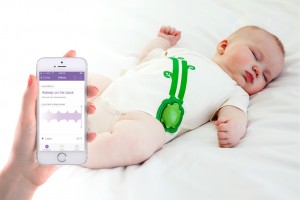 The Mimo is a full body infant’s onesie or kimono that can track a variety of stats thanks to an integrated “Turtle” sensor. In the picture, the green turtle on the outside of the onesie is exactly what we’re talking about. It includes two breathing sensors and a movement sensor that is removable. The onesie is made out of a washable and stretchy type cotton.
The Mimo is a full body infant’s onesie or kimono that can track a variety of stats thanks to an integrated “Turtle” sensor. In the picture, the green turtle on the outside of the onesie is exactly what we’re talking about. It includes two breathing sensors and a movement sensor that is removable. The onesie is made out of a washable and stretchy type cotton.
It will monitor information like breathing patterns, temperature, body position (while sleeping), and more. It can also stream audio to the base unit, similar to a traditional baby monitor.
Instead of being cast directly to a smartphone, the sensor communicates with a base module – that also serves as a charging station – called the “Lilypad” before bouncing to the companion app. You can still monitor your baby from your iOS or Android smartphone, however.
It will provide detailed alerts like “asleep on his/her back,” or “awake for x minutes.” This is a godsend if you work from home and need to crunch or do a little laundry while the little one is napping.
3. MonBaby
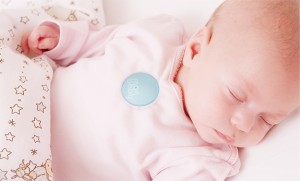 MonBaby is a small wearable that is clipped onto the baby’s clothing. It can monitor breathing activity, but it’s primarily designed to keep an eye on the baby’s movement. It will detect sudden motions like if the baby were to roll over, fall, or leave the proximity of the tracker.
MonBaby is a small wearable that is clipped onto the baby’s clothing. It can monitor breathing activity, but it’s primarily designed to keep an eye on the baby’s movement. It will detect sudden motions like if the baby were to roll over, fall, or leave the proximity of the tracker.
The good thing about it being a snap-on is that it can be used with any outfit. Unlike the Mimo – which is a full onesie that will need to be cleaned periodically – the MonBaby can be detached. This is also great if you need to remove the device for whatever reason, like when someone else is babysitting or your child is at daycare and you don’t want the device lost or stolen.
All the information is synced with a mobile device through a companion app. As parents, you can customize what alerts you receive and when. For instance, if you know your baby is going to be moving around a lot and you just want to keep an eye on their breathing, you can dismiss the movement alerts for a while.
The MonBaby is definitely similar to some of the other devices on this list, but it has its niche.
One MonBaby sensor is $169, and it comes in white, pink, or blue.
4. Owlet Sock
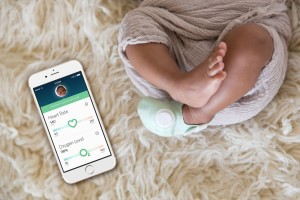 The Owlet sock – or slipper – is a wearable that covers your baby’s feet and keeps them warm. It also doubles as a vitals tracker, thanks to a unique medical technology called pulse oximetry. Hospitals and the Apple Watch also use this same technology to monitor health and fitness stats.
The Owlet sock – or slipper – is a wearable that covers your baby’s feet and keeps them warm. It also doubles as a vitals tracker, thanks to a unique medical technology called pulse oximetry. Hospitals and the Apple Watch also use this same technology to monitor health and fitness stats.
The Owlet will track your baby’s heart rate, skin temperature, and oxygen levels (breathing), and will let you know just how your baby is doing. If there’s no Wi-Fi available that’s fine, as long as you’re within proximity, the base station will still sync the necessary data and sound an alarm if there’s a problem. That means if you take the baby – with the Owlet sock – to their grandparents for a visit and you still want to monitor their vitals without Wi-Fi, it’s possible.
Plus, the Owlet comes with three sock sizes in the box, so it will “grow with your baby.” According to the company, it should fit most babies up to a year and a half, depending on their size.
The Owlet sock bundle is $249.99 and it comes with three different sock sizes.
5. TempTraq
Taking the temperature of a sick baby is not a fun job, nor is it easy to do. Instead of trying to fight an agitated infant, you can rely on TempTraq, a relatively small, wearable thermometer.
Unlike the other wearables for your baby, TempTraq serves only one purpose, to constantly monitor your baby’s temperature in real-time, for 24 hours. It’s a $25, stick-on patch that is designed to be placed against your baby’s skin under their arm (close to the armpit).
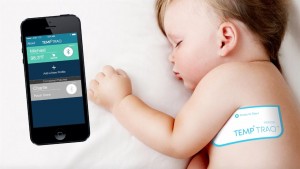 It sends temperature readings directly to a smartphone app letting you know if your baby’s fever has subsided, or if it has gotten worse.
It sends temperature readings directly to a smartphone app letting you know if your baby’s fever has subsided, or if it has gotten worse.
The patches are latex-free so as to avoid allergic reactions from little ones, and you only use them once. Therefore, you cannot rely on them as a regular monitoring tool. Instead, they’re only meant to be used when you’re baby is sick or has a fever.
The best part is that you don’t have to wake your little one to get a reading. They can remain sound asleep, and you don’t have to fumble with a traditional thermometer.
6. Pacif-i
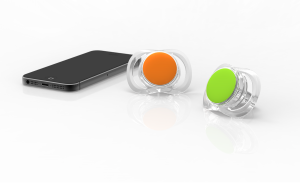 If you decide to use a pacifier for your little one – or binky as some people call them – you can pick up the Pacif-i, which includes a built-in thermometer. The temp sensor is embedded inside the silicon teat, so when your child has it in their mouth it can give readings of their current temperature.
If you decide to use a pacifier for your little one – or binky as some people call them – you can pick up the Pacif-i, which includes a built-in thermometer. The temp sensor is embedded inside the silicon teat, so when your child has it in their mouth it can give readings of their current temperature.
A particularly useful feature allows you to find the pacifier if it goes missing. When you activate the location feature the unit will begin buzzing. This helps you find it easily if it’s slipped behind the cushions of your couch, or underneath the seats of your vehicle.
The Pacif-i syncs temp readings over Bluetooth with a smartphone via the Android and iOS companion apps.
The Pacif-i is £39.99 ($56 USD), and comes in either green or orange.
7. Angelcare AC1200
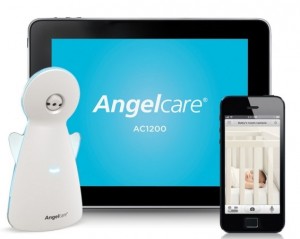 The Angelcare AC1200 is a modern “smart” baby monitor system complete with an under-mattress pad and HD camera. Angelcare is a mainstay in the baby monitor market, so it’s likely you’ve heard the brand name before.
The Angelcare AC1200 is a modern “smart” baby monitor system complete with an under-mattress pad and HD camera. Angelcare is a mainstay in the baby monitor market, so it’s likely you’ve heard the brand name before.
The AC1200 set comes with an under-mattress sensor that monitors movement and sounds an alarm if the baby stops moving for longer than 20 seconds. An HD infrared camera allows parents to remotely monitor their baby visually, instead of just audibly. Furthermore, like traditional baby monitors, there’s also a two-way talk-back radio. This means you can not only hear your baby when in another room, but you can also talk back to them – in a soothing voice – if you’re all tied up.
If you’re fumbling around the nursery in the dark, you can also turn on the unit’s built-in light to see better.
Of course, all of this tech can be controlled from a smartphone – iOS or Android – via Wi-Fi. You can even stream the video to your phone to keep an eye on baby.
As an added feature, the Angelcare AC1200 can play several pre-loaded lullabies and even supports music playback from a local library on your phone.
The Angelcare AC1200 set is $299.99.
8. UVA+B SunFriend
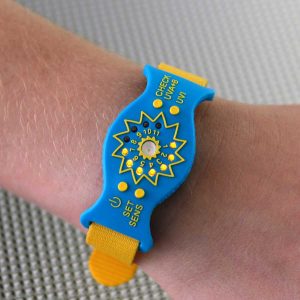 The UVA+B SunFriend is a simple bracelet that measures the wearer’s exposure to UVA and UVB rays.
The UVA+B SunFriend is a simple bracelet that measures the wearer’s exposure to UVA and UVB rays.
After programming your child’s skin color rating, you can strap it to their wrist and let them free! The SunFriend will begin flashing its internal LEDs when your little one has been outside for too long.
This saves you the inevitable headache of dealing with a munchkin that has a severe sunburn. It also protects their fragile skin and helps prevent skin cancer. You don’t have to worry about the device being exposed to water either since it can be submerged at a depth of up to 9 feet (3 meters).
It comes in a variety of styles and colors that you can choose from when you place your order.
The UVA+B SunFriend is $49.99 and it comes in black, green, orange, blue, or grey.
9. Baby Gigl
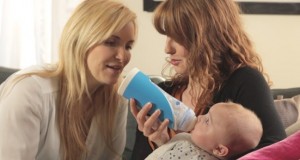 The concept behind Baby Gigl is simple. It slips over the bottom of a baby’s bottle and acts as a cover to monitor their eating habits. This works to not only improve your baby’s wellbeing by ensuring they aren’t eating too much – or too little – but also to improve the feeding session altogether. When you angle a bottle improperly it can cause a whole mess of issues, namely a colicky and upset baby. The Gigl will ping alerts when you start holding the bottle incorrectly so you can adjust.
The concept behind Baby Gigl is simple. It slips over the bottom of a baby’s bottle and acts as a cover to monitor their eating habits. This works to not only improve your baby’s wellbeing by ensuring they aren’t eating too much – or too little – but also to improve the feeding session altogether. When you angle a bottle improperly it can cause a whole mess of issues, namely a colicky and upset baby. The Gigl will ping alerts when you start holding the bottle incorrectly so you can adjust.
It also tracks feeding stats and syncs them with a smartphone app. This is great for parents that have to return to work and want to monitor their baby’s eating habits remotely. You can supply a Gigl cover to multiple people, including a nanny or daycare provider. Then, when you feel the need, you can tap into the app and read up on your baby’s feeding stats.
If you’re worried the wireless signal will harm your baby, you can turn off Bluetooth during a feeding session and then transmit the data after.
The Gigl covers come in multiple colors like red, blue, yellow, pink and green. The Gigl covers aren’t available just yet, but you can sign-up to receive updates in your email.
10. Starling
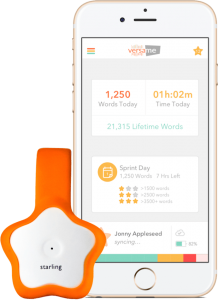 The Starling is a wearable for your baby who is just starting to speak or form words. It is designed to track the number of words that your child speaks and hears throughout their day. The idea behind it is that through the use of big data and custom analytics tools you can ensure your child is learning the right amount of early vocabulary.
The Starling is a wearable for your baby who is just starting to speak or form words. It is designed to track the number of words that your child speaks and hears throughout their day. The idea behind it is that through the use of big data and custom analytics tools you can ensure your child is learning the right amount of early vocabulary.
It clips onto the child’s shirt collar just below the neck. While active it tracks word goals, environmental language patterns, your child’s development progress, and more. You can also take part in activities with your child to help them boost their early learning.
Why is any of this important?
According to the makers of Starling, vocabulary significantly shapes your child’s early progress.
“Did you know that the number of words a child hears before age four is one of the biggest predictors of their future cognitive, social, and emotional success? Over 30 years of research has proven that it’s critical to talk to children during this period of rapid brain growth and development.”
“By age four, a child can be 30 million words ahead, or 30 million words behind. This is known as the “Word Gap.”
As you’d expect, all the data collected by the Starling is synced with a compatible smartphone via a companion app.
You can pre-order the Starling for $169.
The Top Wearables for Your Baby
As you can see, all the wearables included in this list offer some form of convenience, but most importantly peace of mind, especially for helicopter parents. As we said above, it would be more of a hassle to use every single device you see above, but if you use one or two to make your job easier there’s nothing wrong with that.
If you prefer to steer clear because you deem exposure to wireless signals too much of a risk for your baby, there’s nothing wrong with that either.

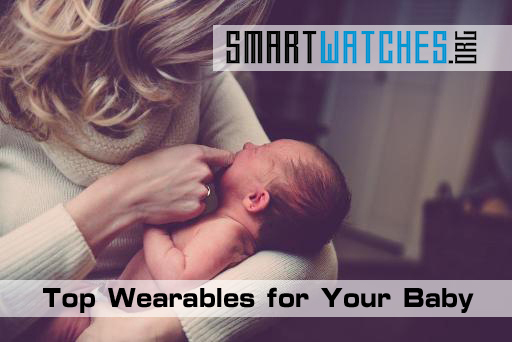
I am looking for a smartwatch or bracelet for my 3 years old daughter that can send me a phone call if my baby cries. and also has live time gps tracking. with lock tampering warning